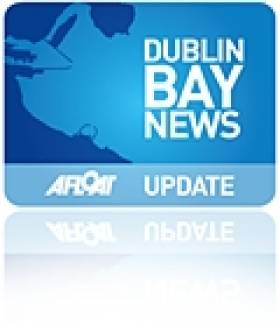Displaying items by tag: Frigate
#NavalVisits – One of the biggest Royal Netherlands Navy ships and a frigate is to visit Dublin Port, so to enable crew members time-off in addition to carrying out diplomatic and trade functions, writes Jehan Ashmore.
The Rotterdam-class HNLMS Johan de Witt, a Landing Platform Dock (LPD) amphibious warfare ship is of 16,500 displacement tonnes. The LPD ship is the second largest unit of the fleet and is named after a key figure in Dutch politics during the mid-17th century. This was a time when Dutch sea trade was notably flourishing and expanding on a world-wide stage that made the United Provinces a leading European power during the Dutch Golden Age.
As for the second naval visitor to the Irish capital, this will be a De Zeven Provinciën-class frigate HNLMS Evertson. The pair are to arrive tomorrow and remain in port over the weekend.
Afloat contacted the Dutch Embassy as to the purpose of the visit which said it would provide rest and recreation time for crew members. In addition to hosting on board receptions for members of the Diplomatic Corps as well as local Dutch businesses. The embassy added that unfortunately due to insufficient time, neither naval vessels will be open to the public.
The 166m HNLMS Johan de Witt can transport army troops along with associated vehicles and dispatch landing craft from the stern located landing well-dock. Above decks, helicopters can also be deployed from a hanger and use of two landing spots. In addition the LPD is equipped with a hospital featuring an operation theatre and intensive care facilities.
A sister of HNLMS Johan de Witt, the leadship of the namesake class HNLMS Rotterdam, have together previously paid a visit to Dublin. The leadship built by Damen Schelde Naval Shipyards was commissioned in 1998, whereas HNLMS Johann de Wit was constructed overseas in 2007 on the banks of the Danube in Galati, Romania. Another notable difference is that the leadship weighs in at a smaller 12,750 displacement tonnes.
Accompanying the LPD will be a De Zeven Provinciën-class frigate HNLMS Evertson of 6,050 displacement tonnes which was also completed by the same Dutch yard group. The 144m frigate has among armaments Goalkeeper guns and Sea Sparrow missiles. A helicopter can also be carried with flight crew joining a crew compliment of 174.
It is almost a year ago since a pair of these frigate class sisters paid a call to the capital following a major UK led naval exercise ‘Joint Warrior’ that involved other European navies.
As for the Dutch Navy, all of their ships have the prefix HNLMS (His Netherlands Majesty’s Ship) which are under the command of Commodore Ludger Brummelaar. On 1st January this year, he was appointed as the new Chief of the Military Household of His Majesty the King.
The Commodore is the first to be promoted to the rank of rear admiral and has succeeded Major General Hans van der Louw.
Tripartite Naval Visitors for Dublin Port
Naval vessels from France, Canada and Belgium are due to make calls to Dublin Port over the weekend, writes Jehan Ashmore.
The first visitor to dock tomorrow will be the Latouche-Tréville (D646) a F70 type anti-submarine frigate of the French Marine Nationale. She is one of seven F70 ASM class anti-submarine frigates and is capable of carrying two 2 Lynx helicopters. In June 2010 the frigate visited London where the 1984 built 3,550 tonnes vessel moored alongside the WW II cruiser, HMS Belfast.
Also due to arrive tomorrow is the Canadian Navy's HMCS St. John's which too is to berth at Ocean Pier. HMCS St. John's (340) is the eleventh 'Halifax' class frigate, measuring some 4,770 tonnes. The multi-role patrol frigate was commissioned in 1996 in St. John's, Newfoundland and is designed to perform three distinct functions: anti-submarine warfare, anti-air warfare and anti-surface warfare.
On Sunday the third international naval visitor to Dublin Port will be the Belgium Navy's Léopold I (F930). This frigate is based in the Quartier Naval Base in Zeebrugge and in 1997 she was commissioned into service in a ceremony by Belgium's Queen Fabiola.
The 2,800 tonnes frigate is capable of taking two helicopters and the vessel can cruise at 21 knots using two diesel engines or is capable of reaching a top speed of 30 knots based from gas turbine power-plants. Léopold I has participated in NATO's Response Force (NRF). For a detailed visual discription of equipment click this link here
Stealth Frigates to Visit Dublin Port
Two Dutch naval frigates, HNLMS Tromp and HNLMS Van Amstel are due to arrive into Dublin Port tomorrow for a courtesy visit over the weekend, writes Jehan Ashmore.
The Royal Netherlands Navy HNLMS Van Tromp is a De Zeven Provinciën-class air-defence and command frigate (LCF). The class has a striking streamlined visual appearance, through the use of stealth design technology. The stealth design is to minimise the vessels signature as much as possible from the detection of enemy vessels using radar.
At 6,050 tonnes, the stealth frigate is one of five built by the Royal Schelde Group, of Flushing, Netherlands. Spain and Germany also participated during the design stage of the 144-metre class which are powered by gas turbine engines capable of reaching 30 knots.
They are equipped with an Oto Breda 127 mm cannon, vertical launch system (VLS) Mk 41 for Evolved Sea Sparrow Missile (ESSM), Standard Missile and Harpoon Missiles. In addition the frigate has a Goalkeeper (rapid-fire gun), a Oerlikon 20 mm machine gun and a Mk. 46 Torpedo weapon system. The vessel also has the ability to carry a Lynx or NH-90 helicopter.
The second frigate to visit the capital is HNLMS Van Amstel, one of two multi-purpose M-class frigates. The frigate which is also known as the Karel Doorman class can be used for surface warfare and anti-submarine warfare. They also have their own air-defence capabilities.
The 122-metre vessels displace 3,300 tonnes and have a two Rolls Royce (Spey 1A) gas turbines delivering 29 knots. The class are equipped with an array of defence / attack armament to includes an Oto Melara 76 mm gun for surface and air targets, a Harpoon weapon system and a NATO Sea Sparrow Vertical Launch weapon system for use against air targets at close range. Like the De Zeven –class the M-class frigate is also capable of carrying a Lynx helicopter.
Royal Navy Anti-Piracy Frigate Visits Dublin Port
The Royal Navy's Type 22 frigate HMS Chatham (F87) which recently returned to UK waters after a seven month deployment on anti-piracy duties off Somalia, visited Dublin Port last weekend, writes Jehan Ashmore.
HMS Chatham was the lead vessel for NATO's 'Operation Ocean Shield' as part of a multi-national task force in the seas off the African state that in recent years has become notorious for piracy.

HMS Chatham departs Dublin Bay and the rocks off Dalkey Island. Photo: Jehan Ashmore /ShipSNAPS
The frigate departed Dublin on Monday afternoon and set an easterly course off the Baily Lighthouse, but surprisingly the 5,300 tonnes vessel returned into the bay. HMS Chatham then crossed the bay towards Sandycove. From there the 148m vessel which has a draft of 6.7m veered in a south-easterly direction, to sweep past off the rocky outcrop, to the north of Dalkey Island and continued southbound off The Muglins.
In mid-November the frigate visited her namesake port on the Medway to mark the 20th anniversary since the vessel's commissioning at Chatham in 1990. The occasion was also the first time that such an event had taken place outside a Royal Navy establishment.
Built in 1988, the vessel was launched from the Swan Hunter shipyard on the Tyne and is normally based in her homeport of Devonport, Plymouth.






























































